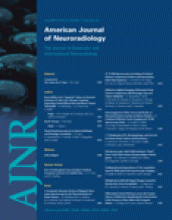Research ArticleHead and Neck Imaging
The Cochlear-Carotid Interval: Anatomic Variation and Potential Clinical Implications
R.J. Young, D.R. Shatzkes, J.S. Babb and A.K. Lalwani
American Journal of Neuroradiology August 2006, 27 (7) 1486-1490;
R.J. Young
D.R. Shatzkes
J.S. Babb

References
- ↵Rubel EW. Ontogeny of auditory system function. Annu Rev Physiol 1984;46:213–29.
- ↵Goycoolea M, Muchow D, Schirber C, et al. Anatomical perspective, approach and experience with multichannel intracochlear implantation. Laryngoscope 1990;100:1–18
- Muren C, Wadin K, Wilbrand H. The cochlea and the carotid canal. Acta Radiologica 1990;31:33–35
- ↵Leonetti J, Smith P, Linthicum F. The petrous carotid artery: anatomic relationships in skull base surgery. Otolaryngol Head Neck Surg 1990;3–12
- ↵Wysocki J, Skarzynski H. Distances between the cochlea and adjacent structures related to cochlear implant surgery. Surg Radiol Anat 1998;20:267–71
- ↵James AL, Papsin BC. Cochlear implant surgery at 12 months of age or younger. Laryngoscope 2004;114:2191–95
- ↵Bhatia K, Gibbin KP, Nikolopoulos TP, et al. Surgical complications and their management in a series of 300 consecutive pediatric cochlear implantations. Otol Neurotol 2004;25:730–39
- ↵Gastman B, Hirsch B, Sando I, et al. The potential risk of carotid injury in cochlear implant surgery. Laryngoscope 2002;112:262–66
- ↵Modugno GC, Brandolini C, Cappello I, et al. Bilateral dehiscence of the bony cochlear basal turn. Arch Otolaryngol Head Neck Surg 2004;130:1427–29
In this issue
Advertisement
R.J. Young, D.R. Shatzkes, J.S. Babb, A.K. Lalwani
The Cochlear-Carotid Interval: Anatomic Variation and Potential Clinical Implications
American Journal of Neuroradiology Aug 2006, 27 (7) 1486-1490;
0 Responses
Jump to section
Related Articles
Cited By...
This article has not yet been cited by articles in journals that are participating in Crossref Cited-by Linking.
More in this TOC Section
Similar Articles
Advertisement











